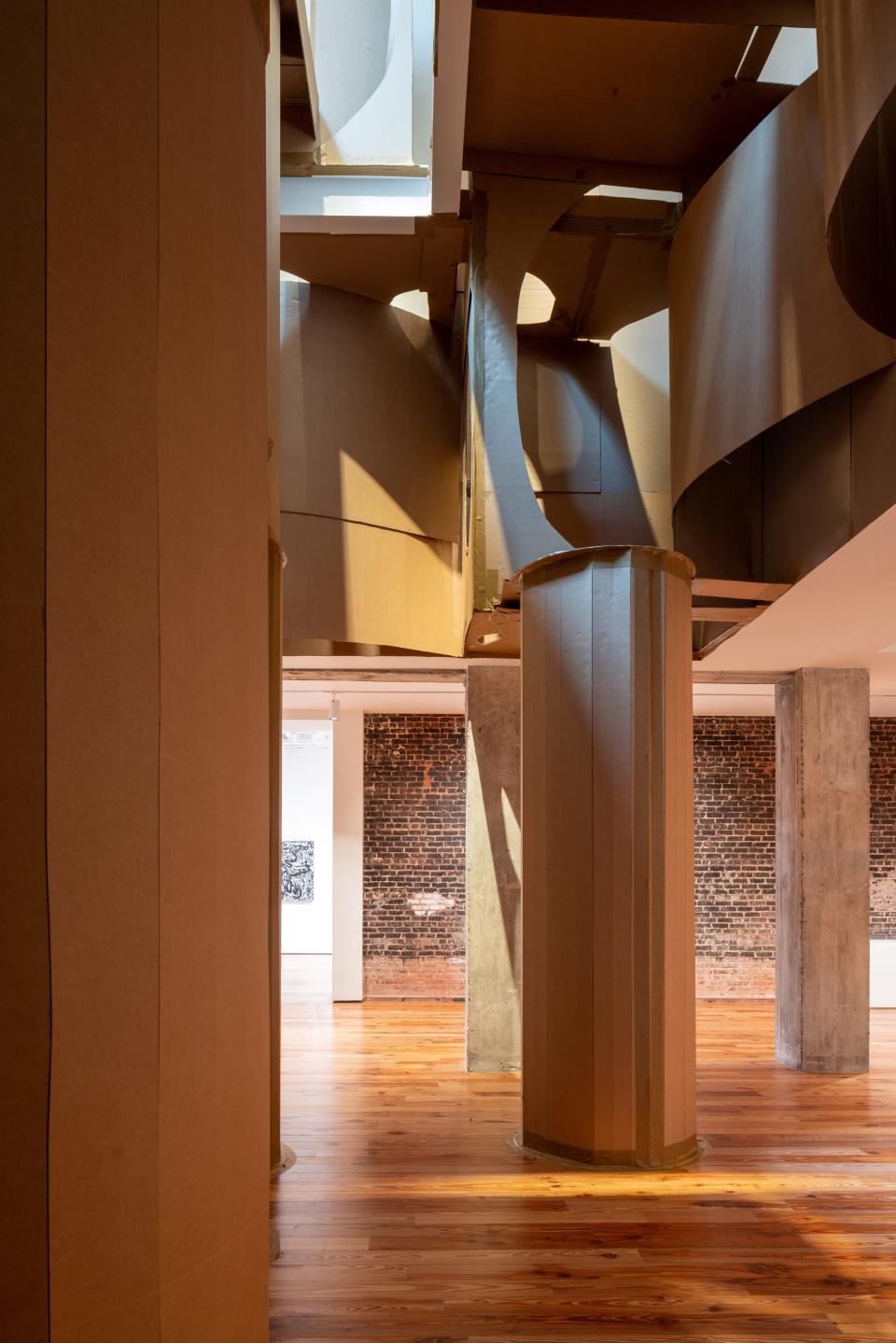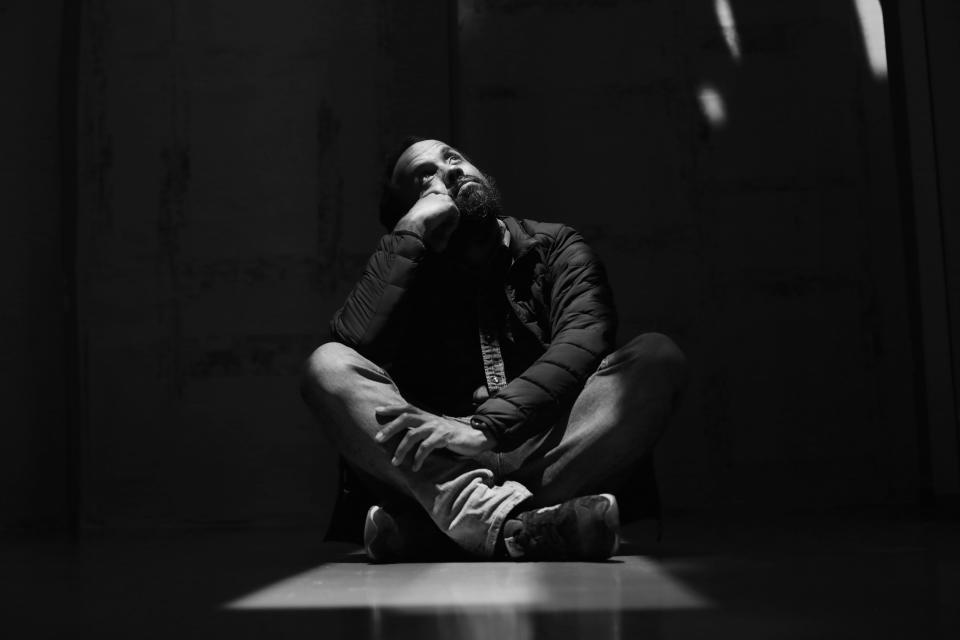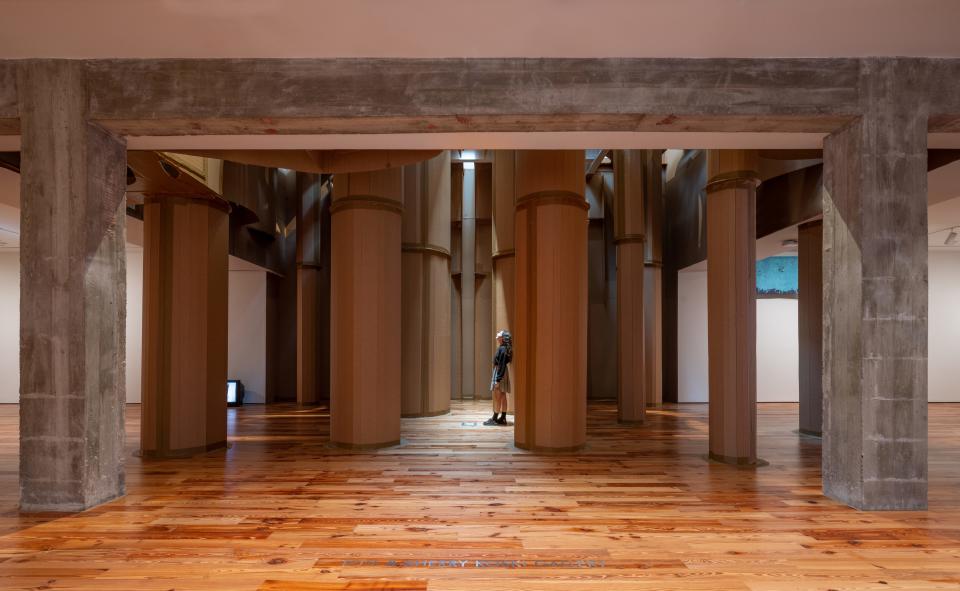Another Dimension: Artist Carlos Bunga plays with cardboard and light
Sarasota Art Museum has much in common with “The Twilight Zone” these days, at least in Carlos Bunga’s “Reassembling Spilt Light” installation. You encounter his improbable, cardboard structure in the Koski Gallery, a few steps away from the steel elevator. It makes a monumental first impression. (Several, actually.)
Rows of massive, cardboard columns recede in perspective. These interpenetrate a false ceiling (also cardboard) of swirling forms. The artist has cut oval and crescent-shaped gaps within this fake ceiling. Light streams in from the skylights in the real ceiling above, projecting bands of prismatic light on the floor. These change throughout the day, depending on the angle of sunlight. It’s an awesome sight, literally.

Bunga’s installation feels like a sacred ruin. An echo of Stonehenge, or the upside-down cathedral in Vincent Ward’s 1998 film adaptation of Richard Matheson’s “What Dreams May Come.” But it could also be the heart of an enchanted forest. Or a cardboard maze where children play. These multiple impressions overlap and tease your imagination to make of it what you will.
But any way you look at it, Bunga’s art evokes a poignant sense of loss. You see it in the “Spilt Light” installation at the heart of this exhibition. You also see it in his accompanying photographs and videos. In “Lamp” (2002), Bunga smashes a light bulb with a hammer and then frantically tapes it back together again with his bare hands, getting a few cuts in the process.
According to Rangsook Yoon, this exhibition’s curator, “I see this video as an allegory for overcoming life’s challenges. The light is broken. Is there anyway to make it whole again?”
She adds that Bunga’s multimedia creations reflect his nomadic, migrant origins. His family fled for their lives in 1975, the final year of Angola’s struggle for independence. By 1983, they wound up in prefab government housing in Portugal. When Bunga eventually returned to his childhood home, he discovered that it had burned to the ground during the fighting. “There’s no place like home.” For Bunga, that sweet sentiment took on a bitter new meaning. His makeshift installations reflect that sense of impermanence. These structures look like they’ll stand forever. But he trashes them immediately after each exhibition ends.

Bunga’s medium and message are equally ephemeral. This multimedia artist has much to say. And he never says the same thing twice. His installations are radically different, and reflect their unique sites. which are never outdoors. Bunga’s makeshift structures all exist inside other structures. They riff on the details around them, but they’re not a form of architectural criticism. His creative process is more organic and spontaneous and a lot like freeform jazz.
Virginia Shearer, the museum’s executive director, notes that Bunga arrives on each installation site without any prior sketching or planning. He arrived at Sarasota Art Museum early this summer and got to work. Armed with X-Acto knives, adhesive tape, metal screws and lots and lots of cardboard, he brought the installation to life. A one-man job?
“We provided the artist with preparers who helped with the heavy lifting,” Shearer says. “Our facilities team also made sure the scaffolding and equipment were safe. Other than that, everything you see is his hands-on creation.”
While Bunga’s art supplies are available at any Dollar Store, his ideas aren’t always that easy to find. In this installation, Bunga found the illumination he needed by looking up. Yoon shares that the skylights on the gallery’s 30-foot high ceiling instantly grabbed his imagination. That’s how the light gets in!
“It reminded him of his video pieces, especially ‘Lamp,’ which is all about gathering fragments of a light source,” Yoon says. “It’s a powerful idea, and the inspiration for the installation’s title.”
Beginning with that epiphany, Bunga intuitively created his “Reassembling Spilt Light” installation over the next three weeks.

The result is the “Twilight Zone” scene mentioned earlier.
A ruined temple. A children’s playground. A magical forest.
On a more mundane level …
A nod to the temporary housing of refugees in a violent world.
It’s bittersweet and beautiful. And the result of blood, sweat and tears.
After going to so much trouble, tossing it all in a dumpster seems like a waste.
But this artistic expiration date is no nihilistic joke. Bunga follows the Tibetan Buddhist monks who create and destroy impossibly beautiful sand paintings. His transitory work reminds you that art is not eternal.
See Bunga’s installation while you can because nothing lasts forever.
‘Reassembling Spilt Light: An Immersive Installation by Carlos Bunga’
Runs through Oct. 29 at Sarasota Art Museum, 1001 South Tamiami Trail, Sarasota; 941-309-4300; sarasotaartmuseum.org
This article originally appeared on Sarasota Herald-Tribune: Artist Carlos Bunga takes visitors to another dimension in new exhibit

